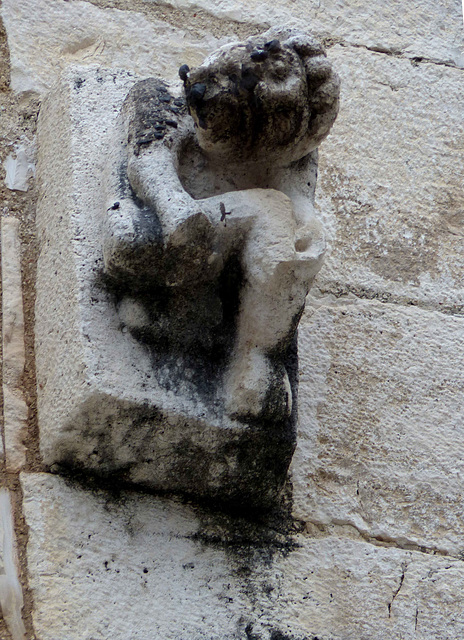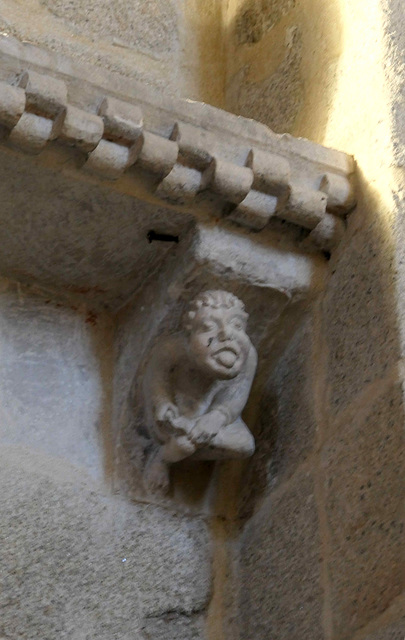
Spinario
A "spinario" is a person withdrawing a thorn from the sole of his foot. The icon can be found already in Hellenistic times. In medieval times the thorn was interpreted as the original sin, so a spinario was the symbol of a sinner, trying to get rid of this sin. This was of course not possible.
Otranto - Cattedrale di Otranto
Otranto occupies the site of an ancient Greek city. It gained importance in Roman times, as it was the nearest port to the eastern coast of the Adriatic Sea.
After the end of the Roman Empire, it was in the hands of the Byzantine emperors until it surrendered to the Norman troops of Robert Guiscard in 1068. The Normans fortified the city and built the cathedral, that got consecrated in 1088. When Henry VI., son of Emperor Frederick Barbarossa, married Constanze of Sicily in 1186 Otranto came under the rule of the Hohenstaufen and later in the hands of Ferdinand I of Aragón, King of Naples.
Between 1480 and 1481 the "Ottoman invasion" took place here. Troops of the Ottoman Empire invaded and laid siege to the city and its citadel. Legends tell that more than 800 inhabitants were beheaded after the city was captured. The "Martyrs of Otranto" are still celebrated in Italy, their skulls are on display in the cathedral. A year later the Ottoman garrison surrendered the city following a siege by Christian forces and the intervention of Papal forces.
-
Otranto had been one of the last Byzantine strongholds in Apulia, but finally Robert Guiscard could take it. It had probably been such a stronghold, as Otranto had hosted an autocephalous bishopric, only dependent of the patriarchal see of Byzantium since 968. So (Roman) Catholicism had to perform something "convincing" for the so long (Byzantine) Orthodox christians. One was to erect a huge church. The Otranto Cathedral was erected, over ruins of a Paleo-christian church from 1080 on and was consecrated in 1088. It is 54 metres long by 25 metres wide and is built on 42 monolithic granite and marble columns.
I had come to Otranto, to see the mosaic. I had planned to stay one night in Otranto, I spent three nights - and still had not seen all the details. I was so overwhelmed, that I took hundreds of photos, but the mosaic is "endless". I will upload only a couple.
It was created by a monk named Pantaleon and his workshop between 1163 and 1165. Pantaleon lived at the monastery San Nicola di Casole, located a few kilometres south of Otranto.
The mosaic covers the nave, both aisles, the apse and the presbytery. This sums up to a total of 1596 m². About 10 000000 (10 million!) "tesserae" were used.
There are scholars, who have counted up to 700 different "stories", that are told here. Though, these "stories" are often disputed, as today's interpretations are mostly very "vague". German historian Carl Arnold Willemsen published the most important book about the mosaic in Italian " L'enigma di Otranto", that since the 1970s is translated in many languages. I followed his theories.
As the church is a parish church, there are benches placed on the mosaic floor. Only for the Sunday service, the ropes are open so that the parishioners can reach the benches. I stayed up to Sunday to mix with the locals.
The central nave has twelve medallions depicting the "Labours of the Months" (and the zodiacs) with scenes the rural activities that commonly took place in the months of the year. This is the area where the benches for the parishioners are placed, so some are only partly visible.
January - March - April
Trani - San Giacomo
Trani may have been founded by Greek settlers, but the known history starts late. After the fall of the Western Roman Empire, it was dominated by Lombards, Byzantines, Saracens and again Byzantines. With the conquest of southern Italy by the Normans and after 50 days of siege by Robert Guiscard´s troops, Trani became part of the Norman Empire in 1073.
Already under the Byzantines, Trani had become an important port for trade with the Orient. The heyday was in the time of the crusades in the 12th and 13th centuries, when crusaders and merchants mainly went to the Holy Land from Bari and Trani. It became an episcopal see in place of Canosa, destroyed by the Saracens. Frederick II built a massive castle. Under his rule, the city reached its highest point of wealth and prosperity.
San Giacomo, in medieval times known as "Basilica of Santa Maria de Russis", was the first cathedral in Trani. It was built in the first half of the 12th century. Following the 1647 earthquake, the portal was put to the northern facade. Under the church is a small crypt, where once the tomb of San Nicola Pellegrino was placed before it was transferred to the "new" cathedral.
The church is adorned with three (!) elephants, you'll find them under photos I took previously. Here is a (damaged) spinario, trying to withdraw a thorn from the sole of his foot.
I have already uploaded many photos taken in Trani from previous visits. So I`ll try to cut the number down this time.
Solsona - Catedral de Santa María
The Iberians and the Romans have been here, Visigoths made their way to Solsona in the fifth century and, three centuries later, the Saracens settled here for about 70 years, until it came under the rule of the Franks. A monastery dedicated to Santa Maria was established in 1070 with connections to the Counts of Urgell.
In the 13th century is evidence of a weekly market. The town was completely encircled by a wall (up to 16 m high) which had 21 towers. The Black Death of 1348 caused a depopulation of the region.
A pre-Romanesque church existed here in 977. The first Romanesque church was consecrated in 1070. Preserved from this church are the three apses, seen on the previous upload, and the bell tower, here seen from the cloister. The present church is Gothic and was begun in the late 13th century. It was completed in the 17th century, so lot of barroque elements can be found. Upto 1593 this was a College church, from there on a Cathedral housing bishop's see, as Pope Clement VIII (on request of Philip II, created the new Diocese of Solsona.
The Bishops of Solsona of course needed a comfortable place to live and work, so a neoclassical episcopal palace was added to the former monastery within the 18th century - and now houses the Diocean Museum.
A spinario (thorn extractor) under the roof.
Vitoria-Gasteiz - Basílica de San Prudencio
The Basilica of San Prudencio is located in Armentia on the southwestern outskirts of Vitoria-Gasteiz.
According to legend, Saint Prudentius was born here in the 6th century. In the 9th century, Armentia was a bishopric until it was transferred to Calahorra in 1087. The Basilica of San Prudencio then became the collegiate church of a canon's monastery, which existed until 1498. It was then that the canons gave up San Prudencio to settle in Vitoria.
The current church of San Prudencio was built towards the end of the 12th century. Between 1773 and 1776 the church underwent major changes. The south facade was demolished and the porch was built. Parts of the church's original sculptural decoration were embedded in the walls of this south porch.
A "spinario", a boy withdrawing a thorn from the sole of his foot.
Lugo - Catedral de Santa María
Lugo, today a city with a population of about 100.000, claims to be the oldest city in Galicia. Its founding dates back to the expansionist policies of the Romans during the time of Emperor Augustus. Among other things, this aimed to permanently pacify the northwest of the Iberian Peninsula. Paullus Fabius Maximus founded 14–13 BC. BC in the name of his emperor, the place Lucus Augusti on the site of a building dating back to around 25 BC. BC existing military camp.
It is the only city in the world surrounded by completely intact Roman walls. The wall is between six and eight meters thick, around twelve meters high at the highest point and has 85, mostly semicircular towers. In Roman times the wall had five gates and today it has ten.
A predecessor church existed on the site in 755. In 1129, Bishop Petro III commissioned the local architect Raimund to build a new church in the current Romanesque style, which was completed in 1273. Later renovations and restorations added elements in other styles.
The cathedral was built on the floor plan of a Latin cross with a length of 85 metres.
A spinario
A person withdrawing a thorn from the sole of his foot. The thorn was interpreted as the original sin, so a spinario was the symbol of a sinner, trying to get rid of this sin.
Jump to top
RSS feed- Latest items - Subscribe to the latest items added to this album
- ipernity © 2007-2024
- Help & Contact
|
Club news
|
About ipernity
|
History |
ipernity Club & Prices |
Guide of good conduct
Donate | Group guidelines | Privacy policy | Terms of use | Statutes | In memoria -
Facebook
Twitter






